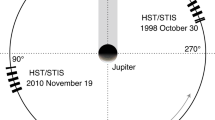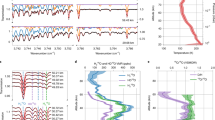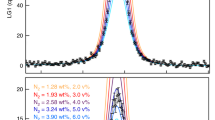Abstract
Previous investigations proved the existence of local density enhancements in Europa’s atmosphere, advancing the idea of a possible origination from water plumes. These measurement strategies, however, were sensitive either to total absorption or atomic emissions, which limited the ability to assess the water content. Here we present direct searches for water vapour on Europa spanning dates from February 2016 to May 2017 with the Keck Observatory. Our global survey at infrared wavelengths resulted in non-detections on 16 out of 17 dates, with upper limits below the water abundances inferred from previous estimates. On one date (26 April 2016) we measured 2,095 ± 658 tonnes of water vapour at Europa’s leading hemisphere. We suggest that the outgassing of water vapour on Europa occurs at lower levels than previously estimated, with only rare localized events of stronger activity.
This is a preview of subscription content, access via your institution
Access options
Access Nature and 54 other Nature Portfolio journals
Get Nature+, our best-value online-access subscription
$29.99 / 30 days
cancel any time
Subscribe to this journal
Receive 12 digital issues and online access to articles
$119.00 per year
only $9.92 per issue
Buy this article
- Purchase on Springer Link
- Instant access to full article PDF
Prices may be subject to local taxes which are calculated during checkout


Similar content being viewed by others
Data availability
All data are publicly available at the Keck Observatory Archive. Any other details of this work are available from the corresponding author on reasonable request.
References
Greeley, R. et al. Europa: initial Galileo geological observations. Icarus 135, 4–24 (1998).
Greenberg, R., Hoppa, G. V., Tuffs, B. R., Geissler, P. E. & Reilly, J. Chaos on Europa. Icarus 141, 263–286 (1999).
Anderson, J. D. et al. Europa’s differentiated internal structure: inferences from four Galileo encounters. Science 281, 2019–2022 (1998).
Carr, M. H. et al. Evidence for a subsurface ocean on Europa. Nature 391, 363–365 (1998).
Pappalardo, R. T. et al. Does Europa have a subsurface ocean? Evaluation of the geological evidence. J. Geophys. Res. 104, 5–24 (1999).
Schubert, G., Anderson, J. D., Spohn, T. & McKinnon, W. B. in Jupiter: The Planet, Satellites and Magnetosphere (eds Bagenal, F., Dowling, T. E. & McKinnon, W. B. 281–306 (Cambridge Univ. Press, 2004).
Johnson, R. E. & Sundqvist, B. U. R. Sputtering and detection of large organic molecules from Europa. Icarus 309, 338–344 (2018).
Johnson, R. E., Killen, R. M., Waite, J. H. & Lewis, W. S. Europa’s surface composition and sputter-produced atmosphere. Geophys. Res. Lett. 25, 3257–3260 (1998).
Brown, M. E. Potassium in Europa’s atmosphere. Icarus 151, 190–195 (2001).
Mauk, B. H. et al. Energetic ion characteristics and neutral gas interactions in Jupiter’s magnetosphere. J. Geophys. Res. 109, A09S12 (2003).
Shematovich, V. I., Johnson, R. E., Cooper, J. F. & Wong, M. C. Surface-bounded atmosphere of Europa. Icarus 173, 480–498 (2005).
Cassidy, T. A. et al. Magnetospheric ion sputtering and water ice grain size at Europa. Planet. Space Sci. 77, 64–73 (2013).
Vorburger, A. & Wurz, P. Europa’s ice-related atmosphere: the sputter contribution. Icarus 311, 135–145 (2018).
Nimmo, F., Pappalardo, R. T. & Cuzzi, J. Observational and theoretical constraints on plume activity at Europa. In AGU Fall Meeting 2007 P51E-05 (AGU, 2007).
Roth, L. et al. Transient water vapor at Europa’s South Pole. Science 343, 171–174 (2014).
Sparks, W. B. et al. Probing for evidence of plumes on Europa with HST/STIS. Astrophys. J. 829, 121 (2016).
Jia, X., Kivelson, M. G., Khurana, K. K. & Kurth, W. S. Evidence of a plume on Europa from Galileo magnetic and plasma wave signatures. Nat. Astron 2, 459–464 (2018).
Arnold, H., Liuzzo, L. & Simon, S. Magnetic signatures of a plume at Europa during the Galileo E26 flyby. Geophys. Res. Lett. 46, 1149–1157 (2019).
Teolis, B. D., Wyrick, D. Y., Bouquet, A., Magee, B. A. & Waite, J. H. Plume and surface feature structure and compositional effects on Europa’s global exosphere: preliminary Europa mission predictions. Icarus 284, 18–29 (2017).
Smyth, W. H. & Marconi, M. L. Europa’s atmosphere, gas tori, and magnetospheric implications. Icarus 181, 510–526 (2006).
Plainaki, C. et al. The role of sputtering and radiolysis in the generation of Europa exosphere. Icarus 218, 956–966 (2012).
Tiscareno, M. S. & Geissler, P. E. Can redistribution of material by sputtering explain the hemispheric dichotomy of Europa? Icarus 161, 90–101 (2003).
Cassidy, T. A., Johnson, R. E. & Tucker, O. J. Trace constituents of Europa’s atmosphere. Icarus 201, 182–190 (2009).
Huybrighs, H. L. et al. On the in-situ detectability of Europa’s water vapour plumes from a flyby mission. Icarus 289, 270–280 (2017).
Hurford, T. A., Helfenstein, P., Hoppa, G. V., Greenberg, R. & Bills, B. G. Eruptions arising from tidally controlled periodic openings of rifts on Enceladus. Nature 447, 292–294 (2007).
Hedman, M. M. et al. An observed correlation between plume activity and tidal stresses on Enceladus. Nature 500, 182–184 (2013).
Rhoden, A. R., Hurford, T. A., Lorenz, R. & Retherford, K. Linking Europa’s plume activity to tides, tectonics, and liquid water. Icarus 253, 169–178 (2015).
Kivelson, M. G. et al. Galileo magnetometer measurements: a stronger case for a subsurface ocean at Europa. Science 289, 1340–1343 (2000).
Nimmo, F. & Manga, M. in Europa (ed. Pappalardo, R. T. et al.) 381–404 (Univ. of Arizona Press, 2009).
Moore, W. B. & Hussmann, H. Thermal evolution of Europa’s silicate interior. In Europa (ed. Pappalardo, R. T. et al.) 369–380 (Univ. of Arizona Press, 2009).
Johnston, S. A. & Montési, L. G. J. Formation of ridges on Europa above crystallizing water bodies inside the ice shell. Icarus 237, 190–201 (2014).
Schmidt, B. E., Blankenship, D. D., Patterson, G. W. & Schenk, P. M. Active formation of ‘chaos terrain’ over shallow subsurface water on Europa. Nature 479, 502–505 (2011).
Quick, L. C., Barnouin, O. S., Prockter, L. M. & Patterson, G. W. Constraints on the detection of cryovolcanic plumes on Europa. Planet. Space Sci. 86, 1–9 (2013).
Bonev, B. P. Towards a Chemical Taxonomy of Comets: Infrared Spectroscopic Methods for Quantitative Measurements of Cometary Water (with an Independent Chapter on Mars Polar Science. PhD thesis, Univ. Toledo (2005).
Villanueva, G. L. et al. Water in planetary and cometary atmospheres: H2O/HDO transmittance and fluorescence models. J. Quant. Spectrosc. Radiat. Transf. 113, 202–220 (2012).
Paganini, L. et al. The formation heritage of Jupiter-family comet 10P/Tempel 2 as revealed by infrared spectroscopy. Icarus 218, 644–653 (2012).
Villanueva, G. L. et al. Strong water isotopic anomalies in the Martian atmosphere: probing current and ancient reservoirs. Science 348, 218–221 (2015).
Paganini, L. et al. Ground-based infrared detections of CO in the Centaur-Comet 29P/Schwassmann–Wachmann 1 at 6.26 AU from the Sun. Astrophys. J. 766, 100 (2013).
Mumma, M. J. et al. Detection of abundant ethane and methane, along with carbon monoxide and water, in comet C/1996 B2 Hyakutake: evidence for interstellar origin. Science 272, 1310–1314 (1996).
Hase, F. et al. An empirical line-by-line model for the infrared solar transmittance spectrum from 700 to 5000 cm−1. J. Quant. Spectrosc. Radiat. Transf. 102, 450–463 (2006).
Kurucz, R. L. The solar irradiance by computation. http://kurucz.harvard.edu/sun.html (Harvard, 1997).
Clough, S. A. et al. Atmospheric radiative transfer modeling: a summary of the AER codes. J. Quant. Spectrosc. Radiat. Transf. 91, 233–244 (2005).
Rothman, L. S. et al. The HITRAN2012 molecular spectroscopic database. J. Quant. Spectrosc. Radiat. Transf. 130, 4–50 (2013).
Villanueva, G. L. et al. A sensitive search for organics (CH4, CH3OH, H2CO, C2H6, C2H2, C2H4), hydroperoxyl (HO2), nitrogen compounds (N2O, NH3, HCN) and chlorine species (HCl, CH3Cl) on Mars using ground-based high-resolution infrared spectroscopy. Icarus 223, 11–27 (2013).
Paganini, L., Mumma, M. J., Gibb, E. L. & Villanueva, G. L. Ground-based detection of deuterated water in comet C/2014 Q2 (Lovejoy) at IR wavelengths. Astrophys. J. Lett. 836, L25–L31 (2017).
Wagner, W. & Pruss, A. International equations for the saturation properties of ordinary water substance. Revised according to the international temperature scale of 1990. Addendum to J. Phys. Chem. Ref. Data 16, 893 (1987). J. Phys. Chem. Ref. Data 22, 783–787 (1993).
Acknowledgements
We thank the staff of the W. M. Keck Observatory for their support throughout our long Europa observation programme. L.P. acknowledges support from NASA’s Keck PI Awards (grant numbers RSA 1541943, 1466335), Solar System Observations (grant number NNX17AI85G) and Solar System Workings (grant number 80NSSC19K0811). L.R. is supported by the Swedish Research Council (2017-04897). The authors recognize and acknowledge the very important cultural role and reverence that the summit of Maunakea has always had within the indigenous Hawaiian community. We are most fortunate to have the opportunity to conduct observations from this mountain.
Author information
Authors and Affiliations
Contributions
L.P. and L.R. planned and performed the astronomical observations and strategy. L.P., G.L.V., A.M.M. and T.A.H. contributed to data analysis. All authors contributed to the interpretation of results.
Corresponding author
Ethics declarations
Competing interests
The authors declare no competing interests.
Additional information
Peer review information Nature Astronomy thanks Melissa McGrath and the other, anonymous, reviewer(s) for their contribution to the peer review of this work.
Publisher’s note Springer Nature remains neutral with regard to jurisdictional claims in published maps and institutional affiliations.
Supplementary information
Supplementary Information
Supplementary text, Table 1 and Figs. 1–11
Rights and permissions
About this article
Cite this article
Paganini, L., Villanueva, G.L., Roth, L. et al. A measurement of water vapour amid a largely quiescent environment on Europa. Nat Astron 4, 266–272 (2020). https://doi.org/10.1038/s41550-019-0933-6
Received:
Accepted:
Published:
Issue Date:
DOI: https://doi.org/10.1038/s41550-019-0933-6
This article is cited by
-
Oxygen production from dissociation of Europa’s water-ice surface
Nature Astronomy (2024)
-
MASPEX-Europa: The Europa Clipper Neutral Gas Mass Spectrometer Investigation
Space Science Reviews (2024)
-
Planned Geological Investigations of the Europa Clipper Mission
Space Science Reviews (2024)
-
The Europa Clipper Gravity and Radio Science Investigation
Space Science Reviews (2023)
-
Solar System Science with the Orbiting Astronomical Satellite Investigating Stellar Systems (OASIS) Observatory
Space Science Reviews (2022)



